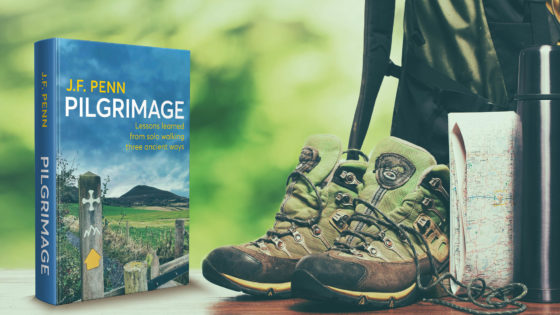Jan 07 2023 34 mins 21
How can walking in the path of history put life in perspective? How can you find a glimpse of the divine in unexpected places?
In this episode, I share two chapters from my book, Pilgrimage: Lessons Learned from Solo Walking Three Ancient Ways. You can buy the audiobook, as well as the special edition hardback, paperback and ebook, at www.JFPenn.com/pilgrimage
Walking in the path of history puts life in perspective
“Nothing ever is, everything is becoming… All things are passing and nothing abides.” —Heraclitus
On each of my three pilgrimages, I encountered places where I was aware of walking through history, where there was a sense of life being but a brief flash of light across the span of time. My passing on each route was momentary, but pilgrims have walked the same ways for hundreds of years and will continue to walk for generations to come.
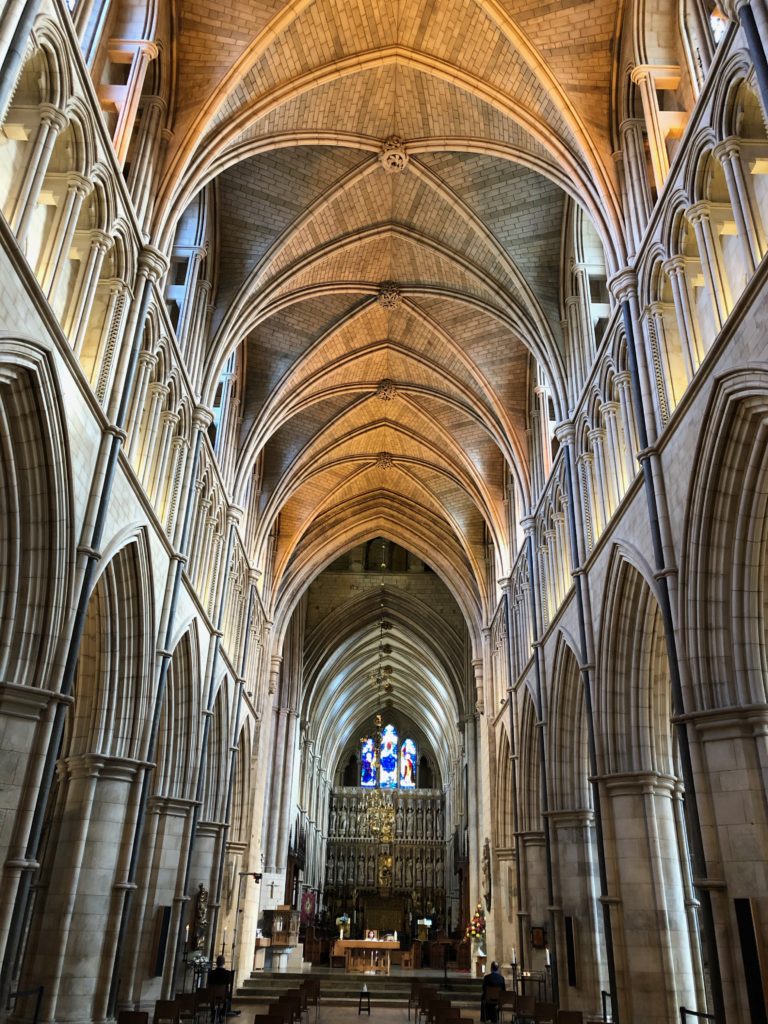
The three historic cathedrals are must-visit locations — Southwark Cathedral and Canterbury Cathedral on the Pilgrims’ Way, and the Cathedral of Santiago de Compostela at the end of the Camino. Each has their splendours, and it’s worth allowing extra time to visit them. In the same way, the ruined abbey of Lindisfarne and its associated church are insights into history — but these are all obvious highlights.
Here are some other places where I felt a historical perspective.
Mosaic mural on the Old Kent Road, London, England
The first day’s walk on the Pilgrims’ Way from Southwark Cathedral is through gritty, urban sprawl along a main road, dense with traffic. It might not look like much, but this is the Old Kent Road, originally built by the Romans, linking London to the coast near Dover, and later renamed Watling Street by the Anglo-Saxons.
At a busy corner with Peckham Park Road, under the overhanging porch of the Everlasting Arms Ministry, lies a gigantic thousand-square-foot mosaic mural. The History of Old Kent Road by Adam Kossowski has separate panels, each portraying an era of history. The foundation of the city by Romans in their togas surrounded by soldiers with military standards, then medieval London with Chaucer’s pilgrims heading for Canterbury and a quote from the poem. King Henry V rides in triumph along the road after the battle of Agincourt, followed by the rebellion of Jack Cade against the government. King Charles II reclaims the throne in the next panel, and then modern London emerges with its British ‘bobby’ policeman, Pearly Kings and Queens with their mother-of-pearl button suits, and the factories of the city with modern cars driving along.
The mural encapsulates two thousand years of history and yet most pass by without realising that the stones they drive over or walk along have witnessed such historical events.
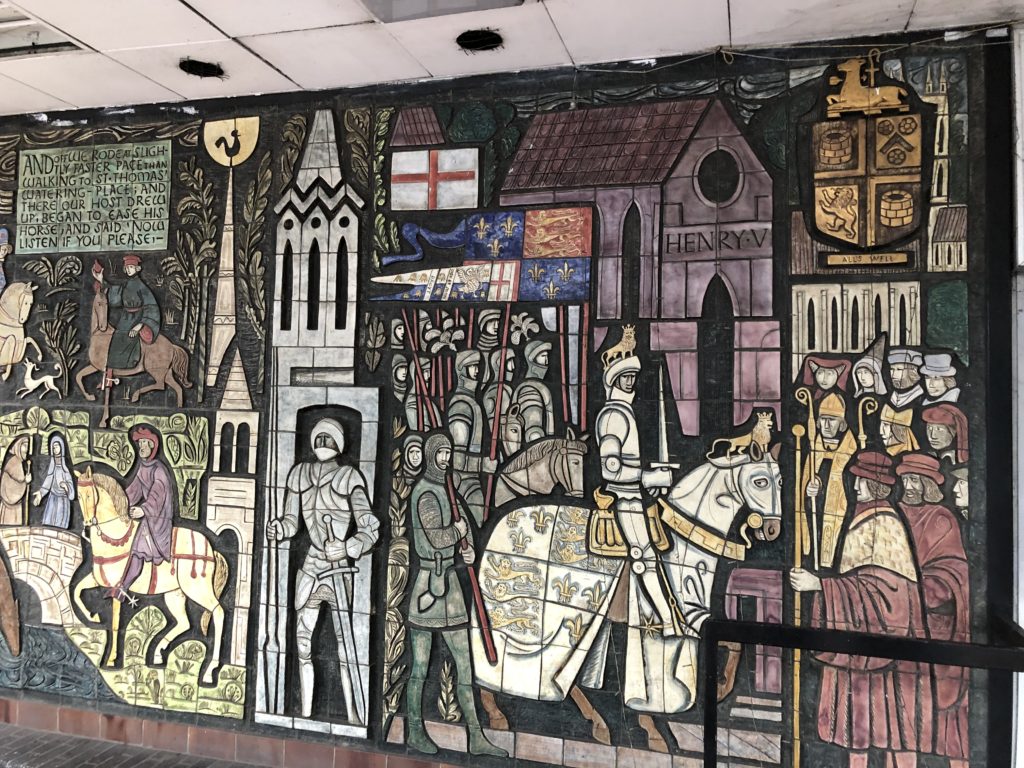
The artist himself represents another aspect of modern history. Adam Kossowski was Polish and arrived in the UK as a refugee from the Soviet labour camps in 1943. As well as this mural, he created many other artistic works, including the History of the Carmelites of Aylesford, at the abbey, which also lies on the Pilgrims’ Way and where he was buried after his death in 1986.
Lesnes Abbey, London, England
The ruins of twelfth-century Lesnes Abbey (pronounced ‘lane’) lie on the Pilgrims’ Way in an ancient woodland in east London. Founded in 1178 by the Chief Justiciar to Henry II, it may have been part of a penance to atone for the murder of Archbishop Thomas Becket.
After the Dissolution of the Monasteries in the sixteenth century, the abbey fell into ruin and was eventually lost to farmland before being restored in modern times. The ruins now feature much-appreciated public toilets and a cafe along the Green Chain Walk that forms part of the Pilgrims’ Way.
There is a memorial of three triple archways that overlook the ruins, and an ancient mulberry tree with the skyscrapers of the city of London framed on the horizon.
The mulberry tree represents patience, as it will not bud until there is no danger of frost. Its red berries also represent sacrifice, as depicted by Shakespeare’s forbidden lovers Pyramis and Thisbe, who died under a mulberry bush, their blood staining the berries red.
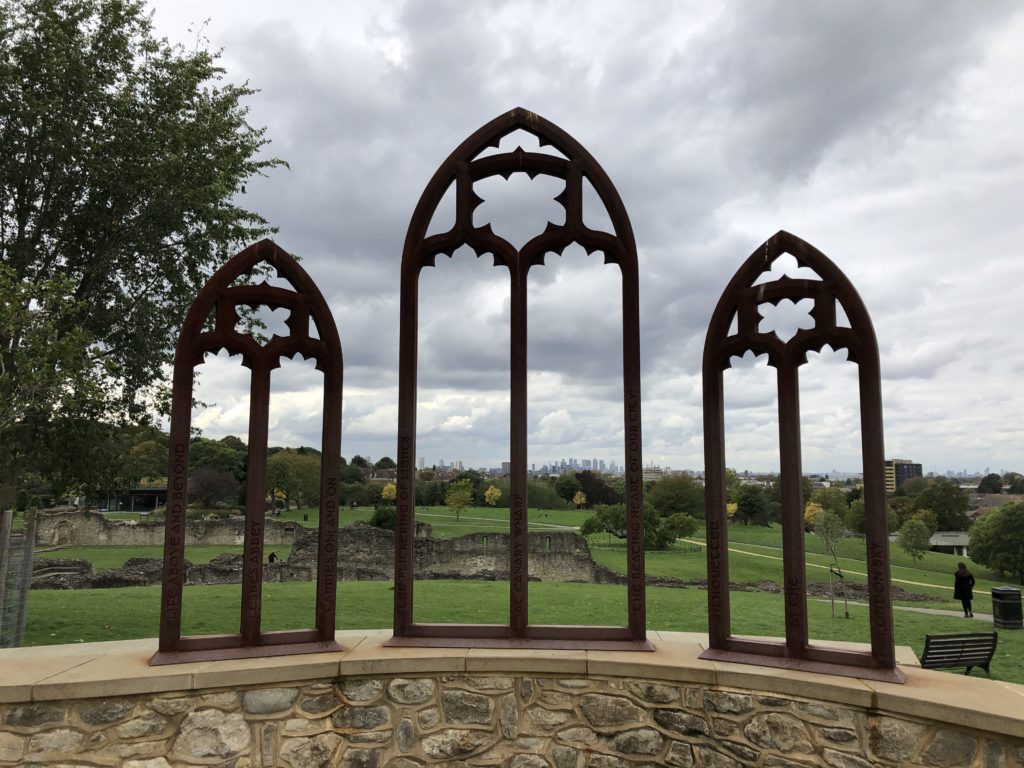
Lesnes Abbey is a place of ancient nature and medieval faith against a backdrop of modern London. Well worth a visit.
The cadaver tombs of Southwark and Canterbury Cathedrals, England
There are unusual cadaver tombs in both Southwark and Canterbury Cathedral, at the beginning and the end of the Pilgrims’ Way. These are rare depictions of the deceased as corpses as opposed to the grand effigies usually sitting above the tombs of nobility.
The Southwark cadaver is the medieval tomb of Thomas Cure, who died in 1588, the same year as the Spanish Armada, during the reign of Elizabeth I. Its skeletal frame is weathered by time, its face disintegrated. It’s clearly a dead body, partially wrapped in a shroud, a simple representation of the inevitability of death.
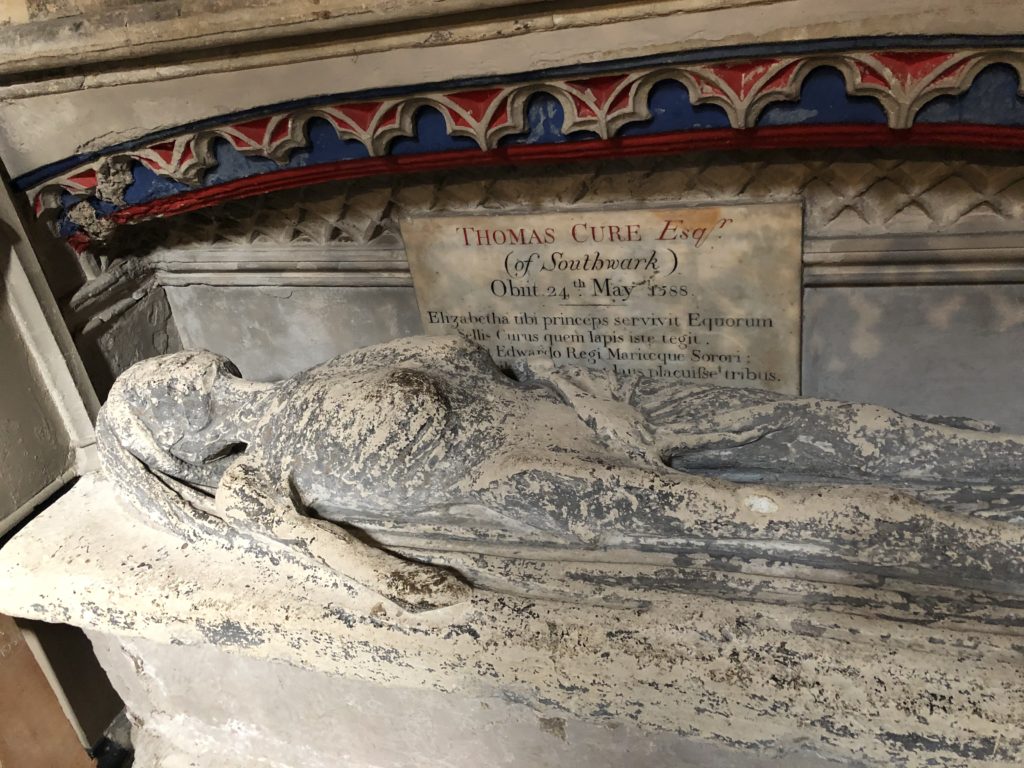
The Canterbury cadaver tomb is on an entirely different scale in terms of grandeur. The tomb of Archbishop Henry Chichele, who died in 1443, has two levels, one showing the effigy of the deceased man in full ecclesiastical robes and, underneath, the cadaver stripped of all its finery, lying naked except for a shroud. It’s surrounded by an ornately decorated arch with figures from church history. A tour guide told me that the archbishop had the tomb built many years before his death so he could look at it every day and contemplate his end.
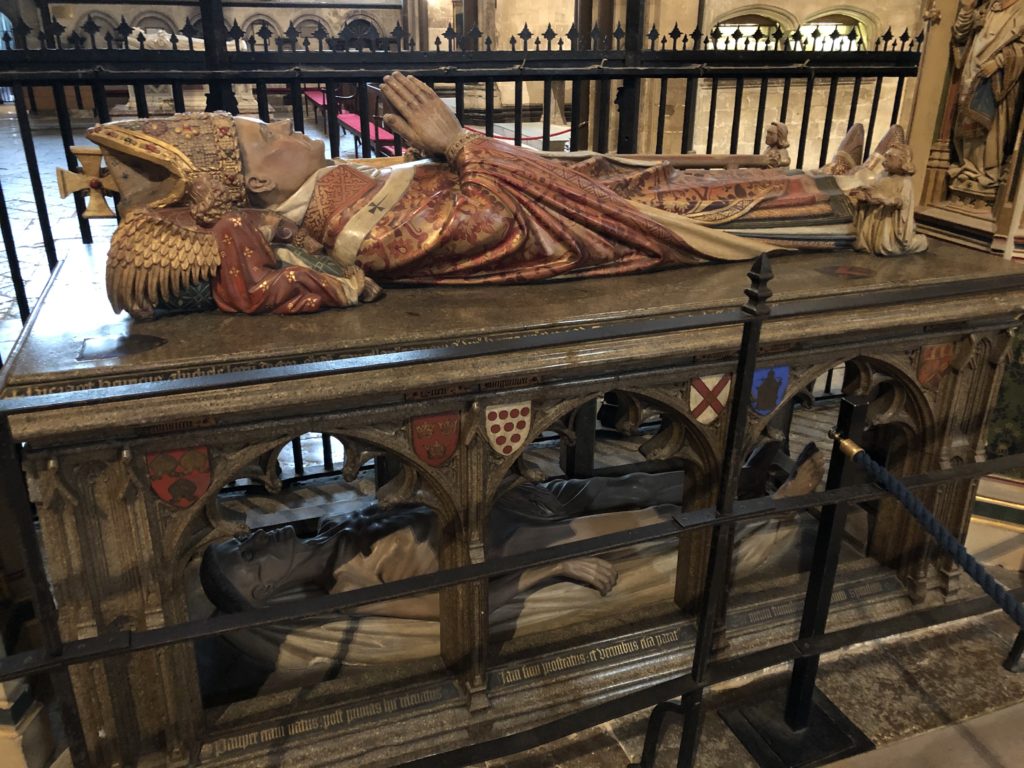
St Cuthbert’s Cave, Northumberland, England
This natural sandstone cave lies within a National Trust reserve on the final day’s walk towards Lindisfarne, Holy Island. The cave has a wide mouth and is ringed by a wood of Scots pine. According to legend, the monks fleeing from a medieval Viking invasion stopped in the cave with the remains of St Cuthbert.
It doesn’t really matter if his body lay there over a thousand years ago. The cave is clearly a natural shelter from the dark and cold and wild weather, and humans certainly rested and slept here over millennia. There is fire damage and graffiti, both old and new, evidence of people making their mark across time.
On my approach to the cave, an adder with its distinctive zig-zag markings crossed the path in front of me. A protected species, the adder is the UK’s only venomous snake, but they are secretive creatures and rarely seen. I had never seen one in the wild before, and it was a precious moment.
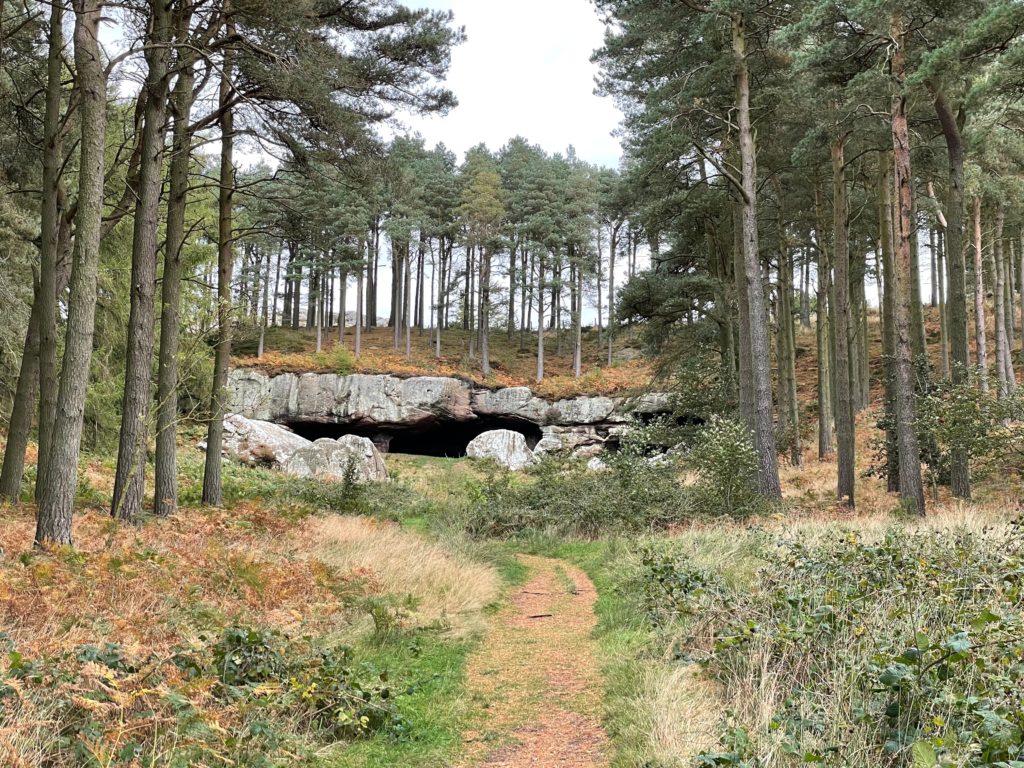
As I sat on a rock in the rain eating my lunch, there was a sense of being part of an ancient environment. If I slept in the cave in the dark of night, perhaps I might hear the crackle of ancient flames and the whisper of the long-dead.
Memento mori — Remember, you will die
While walking an ancient route like the Camino de Santiago helps the pilgrim to reflect on mortality, it is almost impossible to comprehend a thousand years of pilgrims walking ahead and many more coming behind.
But while I walked in September 2022, I had a vivid reminder of memento mori — remember, you will die — as Queen Elizabeth II died at the age of ninety-six on the second day of my pilgrimage. Snippets of her life punctuated each following day of my Camino on TV in coffee bars and glimpses of newspapers, and I couldn’t help but read some of the UK media coverage online when resting at the end of the day.
It was strange to walk outside of my country during such a historically significant week. I remember seeing newly carved statues of the Queen and Prince Philip mounted outside the cathedral in Canterbury on my first pilgrimage in October 2020. The stone was paler than the other sculptures of historic monarchs. The features weren’t yet weathered — and of course, both were still alive then. There was a sense of standing next to living history, as another generation passed, and now they are both gone.
I am not an ardent royalist by any means, but the Queen was a constant across my life, as she was for many people in the UK and around the world. As I walked my Camino, the news was full of pictures of her as a young woman, then middle-aged going through the trials of life, then an old woman at her husband’s funeral, and in her final days, standing bent over and smiling as she welcomed the new Prime Minister. The span of an extraordinary life against the backdrop of history.
Her life passed by, as will mine and yours. Even a Queen cannot hold back the end.
I walked into Santiago de Compostela on the day of her funeral and, as I rested in my hotel that afternoon, I watched her coffin being lowered into the vault at Windsor Castle. It was a fitting end to my pilgrimage and underscored the sense that something must die for change to happen — new life will emerge from the ashes of the old.
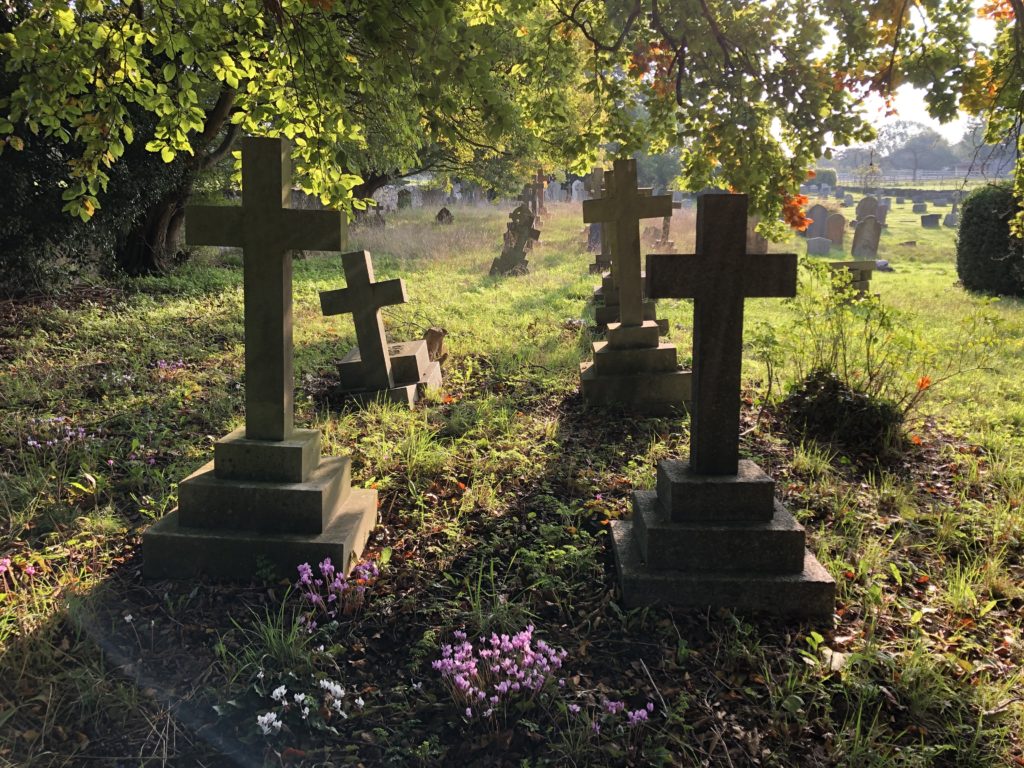
Questions:
- What aspects of history form part of your pilgrimage route?
- Which are you interested in visiting?
- Sometimes it is the unexpected places that mean the most. How can you keep an open mind so serendipity may alight at other times?
- How can ‘memento mori’ help you put life into perspective?
A glimpse of the divine in sacred places
“All such sites are regarded as thin places, set apart from the world, moving to a different drum, and possessed of an innately special atmosphere because of their connection to another, higher dimension.” —Peter Stanford, Pilgrimage: Journeys of Meaning
The paths and final destinations of great pilgrimage routes have been imbued with so much meaning over centuries, they call both to those who believe and those who don’t follow a particular faith.
The depth of history and belief of the faithful over generations impart a deeper resonance to certain places where the veil is thin, and you are closer to God, or a sense of the divine. Your pilgrimage will have moments of spiritual meaning if you are open to them, although, of course, they may come at unexpected times.
Here are some moments where I glimpsed the divine while walking these ancient ways.
Crayford Ness, near Dartford, England
I was exhausted as I emerged from the Thames Path Walkway and passed through the gritty, urban sprawl of Erith in East London. I’d already walked around thirty-eight kilometres that day, and I still had several more to walk before I reached my hotel in Dartford. It was October, and dusk was fast approaching.
I took a wrong turn and found myself alongside a busy dual carriageway, the noise of so many cars jolting me back into the modern world. I considered getting a bus or even a taxi to carry me through the last few kilometres, but I had promised myself I would walk every step of my pilgrimage and this was only the first day.
As I trudged on through an industrial estate echoing with the rumble of cranes hauling heavy equipment, the screech of trucks, and the shouts of workers, I wondered what the hell I was doing there.
But then the path opened out onto a flood plain where horses grazed on common land, and the way ahead ran alongside the river once more. This was Erith Saltings, an ancient salt marsh, part of the Thames estuary that can’t be built upon as the tide may wash it away. The remains of an ancient fossilised forest dating back to Neolithic times over five thousand years ago lie partially submerged beneath the water, and on the opposite bank lies the Rainham Marshes Nature Reserve. Oyster catchers waded in the shallows, and a regal heron rested on a solitary spar emerging from the water.
But this is no pristine wilderness. The path runs alongside a recycling centre, with the stink of waste coming from huge sorting bins filled with all kinds of discarded human detritus.
I turned my back on the industrial centre and looked out over the salt marsh, as a flock of Canada geese flew overhead, calling to one another in the dusk. With the warbling trill of skylarks and the whistle of the wind off the river, I stood in a moment out of time. The ancient forest buried beneath the waters once echoed with birdsong, and, after human civilisation has passed away, the birds will sing on.
Whether it was the juxtaposition of such ugliness alongside natural beauty, or the timelessness of the fossilised forest with the ephemeral sound of birdsong — or just my exhaustion — I stepped into a thin place there.
After a time, a metallic crash jolted me back to the present. I turned to see an urban fox waiting by the side of the industrial centre, an inquisitive look on his face as I passed by.
My pack seemed lighter as I walked the rest of the way along the River Darent into Dartford, grateful that I had not skipped this part of the journey.
Evensong at Canterbury Cathedral, England
It was dark outside when I entered the cathedral, my final destination on the Pilgrims’ Way. With my mask in place, I walked to my solitary chair in the nave, directed by a similarly masked attendant who made sure all present followed pandemic rules. There were a few other people there, all separated by several metres, the space around us cold in the autumn evening.
The choir entered in a line, walking across the nave in robes of purple, all of them masked. They arranged themselves on the steps in front of the quire screen, physically distanced, before removing their face coverings.
They sang psalms in Latin, their voices soaring high into the vault above, harmonising together even as they stood so far apart. This cathedral was built for the glory of God and these men sang for Him too, but also surely for the sheer joy of human voices coming together in song at a time of so much separation.
Ancient stone, ancient words, ancient faith — and the transience of each note disappearing into silence once more.
I stayed for the service, but it was the practice before that truly moved me, and those minutes almost alone in the cathedral nave that freed my spirit. A fitting end to my Pilgrims’ Way.
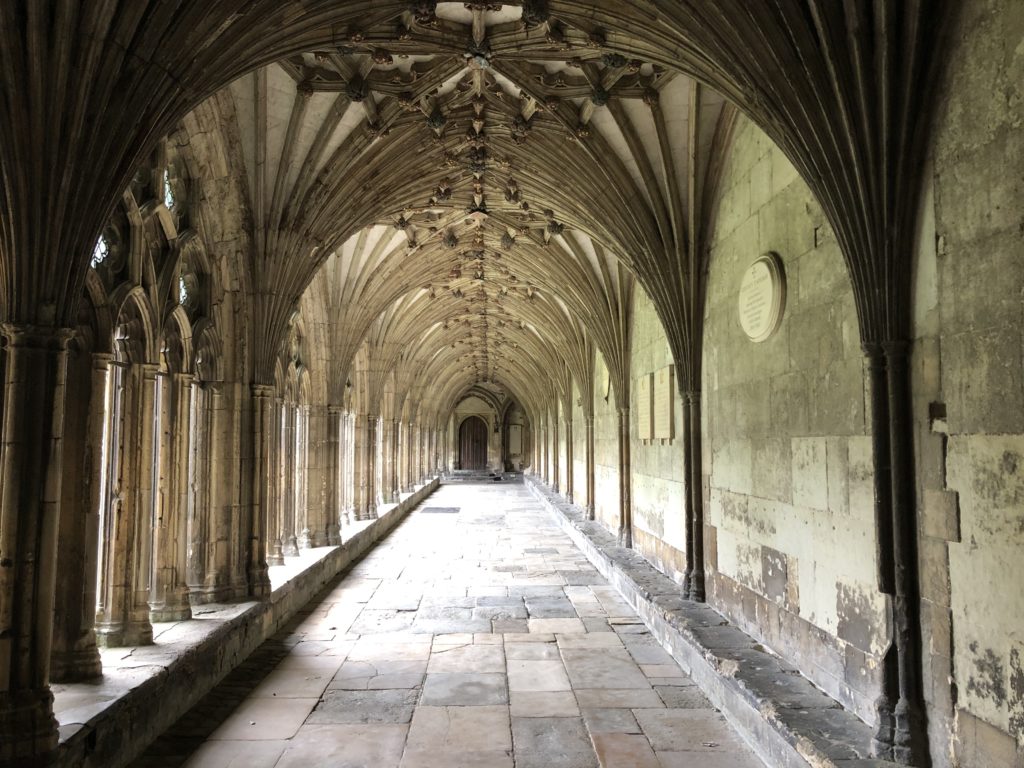
Walking across the sands to Lindisfarne, Holy Island
I rose before the dawn on the final morning of my pilgrimage on the St Cuthbert’s Way. I stood at a farm gate looking east into the rising sun, next to a field of curious alpacas and chickens quietly clucking in their roost. As the darkness lifted, the castle on Lindisfarne stood in silhouette against bars of coral clouds, shot through with luminous yellow and pink as the sun rose above the horizon.
The end was so close now.
I was relieved because my muscles ached and I wanted to stop and rest and not walk another day, but I was also sad that the journey was almost over. I wanted to finish the path, but also to keep going. Yet there is nothing beyond Lindisfarne, only the North Sea, and I would reach the furthest point that day.
The clearing sky indicated that the weather would be fine for my crossing of the sands, but I still felt some trepidation. The tidal website warned it was only safe to cross with a guide, and there were tales of walkers lost to the sea in the fog, or cars stranded on the causeway as water reclaimed the land.
But I had prepared, and I knew it was safe to cross. All that remained was to step off onto the sands that the sea left behind.
As the sky turned pale blue, I returned to the farm to retrieve my pack, hefting it onto my shoulders for the last time.
It was only a few kilometres from the farm to the edge of the causeway. I walked with Dave and Keith, pilgrims I had met a few days back after getting lost on the boggy moor. On the way down, Keith and I discovered we had both studied theology and read many of the same books. Whereas I had turned my degree into the basis of my thrillers, he had spent a life of service as a social worker, supporting those with mental health issues. We disagreed on matters of faith, but there was a spark of intellectual connection. Pilgrimage encourages the discussion of such deeper matters and I fleetingly wished we could carry on our debate. But we were soon at the edge of South Low, where the tide had turned and the waters were receding.
Several enormous concrete blocks lay just before the causeway, anti-tank sea defences from World War II. There were signs warning of unexploded ordnance in the area as well as quicksand, and more warnings of what could happen if the tide cut you off. It was hard to imagine the military swarming over this area, now a National Nature Reserve, protected for the biodiversity of life within its shifting sands and tidal waters.
A series of marker poles stretched across the sand to Lindisfarne, interspersed by two wooden refuges on stilts for those who could not beat the tide. The sky was pale blue and clouds scudded high above, and I could see all the way to Holy Island. It was safe to cross.
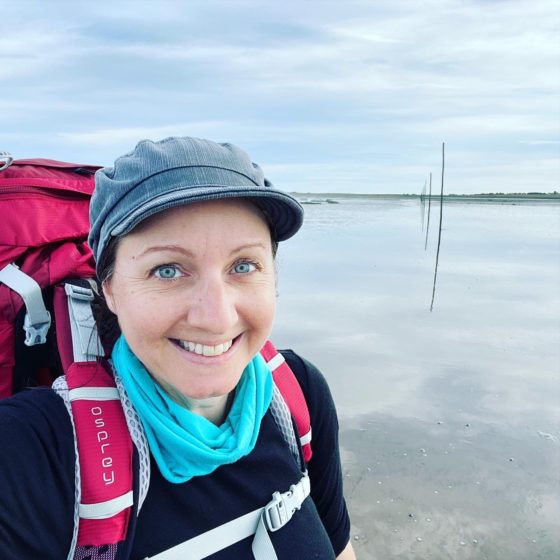
I rolled my walking trousers up above my knees. Walking barefoot was the traditional way to cross, but I had blisters and raw patches on my feet, so I wore my walking shoes with waterproof socks. I grasped my poles to steady myself — then stepped off the causeway onto the sand.
I wanted to walk the final stretch alone, so after taking photos with Keith and Dave, I let them stride ahead.
The sand was initially firm underfoot as I followed the path of tall wooden poles towards Holy Island. I skirted around deeper pools of water, stepping over the wiggly casts of lugworms and the footprints of wader birds. Gulls flew overhead, their calls piercing the air.
There were patches of grass in places and channels of deeper water to navigate, with sections of sucking mud which I clambered through, using my walking poles to gain a more even footing. I almost lost one shoe in the mud, and it was certainly a more challenging walk than I expected. Less a stroll across firm sand, and more an adventure to reach the final destination.
The lower parts of the wooden guide poles were covered with barnacles and bladder wrack seaweed, surrounded by winkle shells and long strands of sea grass. Crabs scuttled in the shallow water, trying to sink away from the light. The upper parts of the poles that lay above the tide were stark white, reflecting the morning sun, and I could imagine pilgrims spotting them with relief on a foggy crossing.
I stopped halfway across and turned my back on the causeway, looking south across the water to Bamburgh Castle in the distance. A mournful sound pierced the air, a low moan like a chill wind sweeping through ruins. The call of grey seals out on the sand flats, singing as they have for generations of pilgrims. I was just one more in a long line stretching back through history, and my footsteps would wash away with the tide like all who walked here before me.
The crossing took about ninety minutes, with time enough to navigate slowly around the mud and deeper water channels. I finally clambered up the bank on the other side and sat on a bench, looking back at the mainland as I changed into dry shoes.
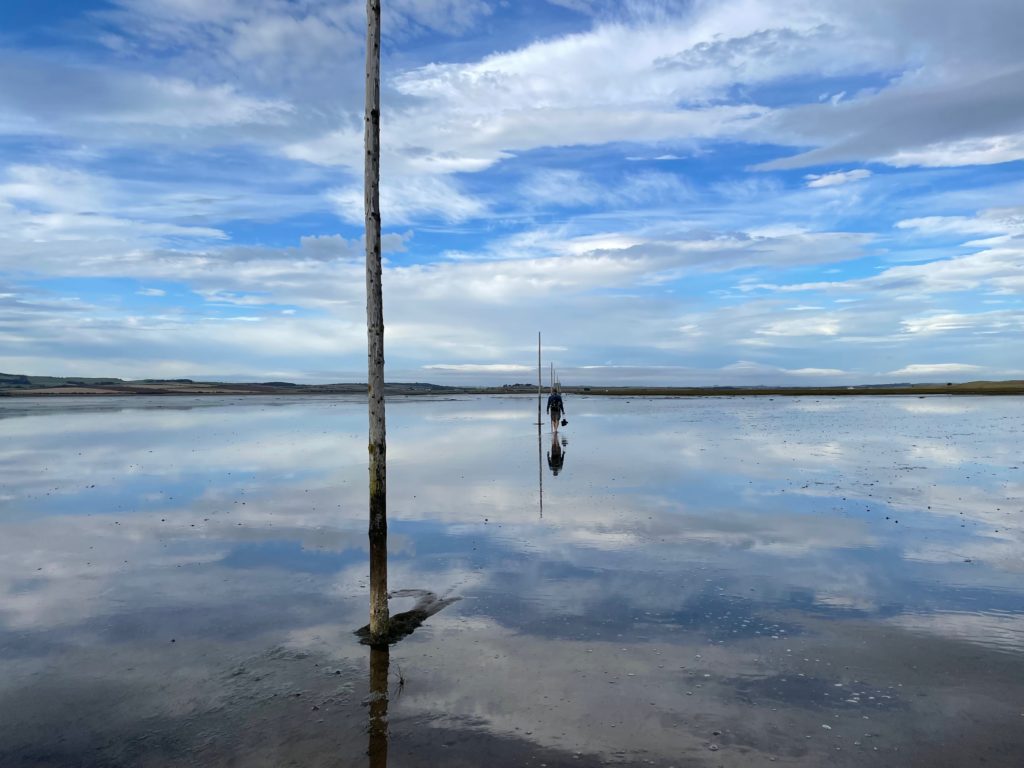
As with my arrival at Canterbury Cathedral a year ago, there was no fanfare, no one cheering the finish line of my pilgrimage. Only a quiet sense of satisfaction that I had accomplished what I set out to do.
After one last look back at the crossing, I walked into Lindisfarne village. After days of solitude, it was a shock to find hundreds of day-trippers pouring out of coaches and cars, streaming over the causeway while it was open during the narrow tidal window. Throngs of tourists rammed into ice cream shops, artists’ studios, and cafes, spilling out into the narrow streets.
While I ate a local crab sandwich in front of the Lindisfarne Mead shop, I wondered what St Cuthbert would have made of the modern Holy Island. There was a frenetic energy about the place as day-trippers rushed to see everything before hurrying back to escape the incoming tide. Some people glanced sideways at me, in a very judgmental English way, as if they didn’t appreciate my muddy pack and dishevelled appearance. It was strange to re-enter the real world again.
I hoisted my pack back on and walked to the ruined abbey while it was still open and then visited the parish church of St Mary the Virgin. A full-sized statue of monks carrying the coffin of St Cuthbert stood inside, and I felt more of a connection with those medieval walkers than the modern religious tourists filling the aisles.
As the island emptied, I walked east to Lindisfarne Castle along the shore. Tourists ran in the opposite direction to catch their buses and I was grateful I’d booked a night on the island when it became quiet once more.
I walked until I reached the coast, where cairns of balanced stones stood overlooking the rough waters of the North Sea. The lands beyond were those of Norway and Denmark, and this was the way the Vikings arrived in the eighth century, bringing violence to the abbey and causing the monks to scatter.
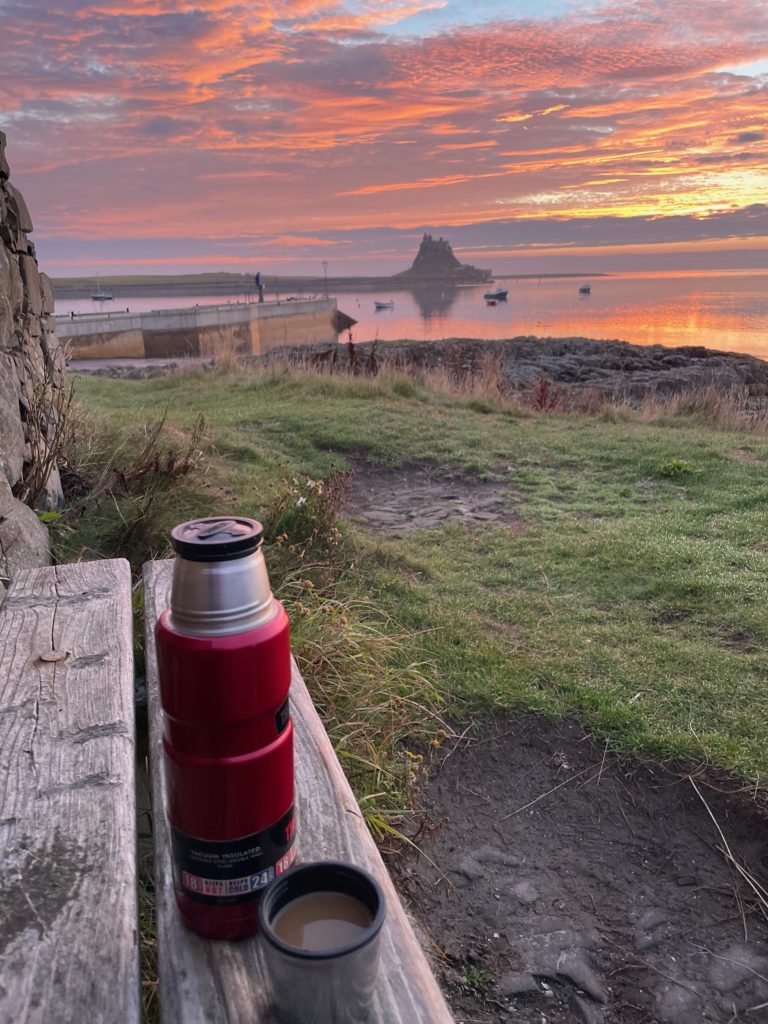
I wrote about Lindisfarne in my novella Day of the Vikings, a modern-day thriller set against the history of invasion and a supernatural power called down from the ancients. Now finally there in person, I sensed a different power. One that emanated from the island and the tide. There was a part of me that wanted to stay there, to sink into island life, and allow the tide to cut off my access to the wider world.
As I walked back from the castle, a murmuration of starlings swooped above the wetlands. As they soared in unison, forming and reforming different shapes in the twilight, I remembered seeing the same thing at Stonehenge a decade ago. Another place where the veil is thin, a glimpse into a timeless realm where I am just another pilgrim in another sunset.
Questions:
- Where have you experienced this sense of the divine or felt that the veil is thin?
- How can you remain open to the spiritual aspects of pilgrimage without expectation of such moments?
Pilgrimage is available now: www.JFPenn.com/pilgrimage
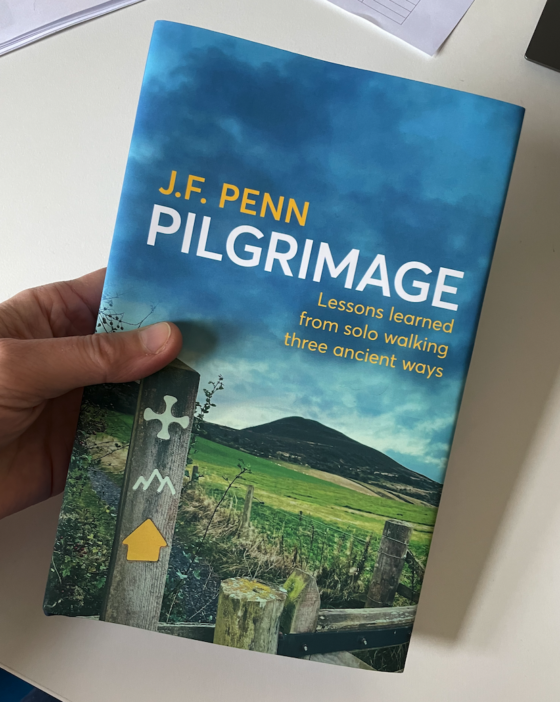
The post Pilgrimage: The Perspective Of History And Glimpses Of The Divine appeared first on Books And Travel.
